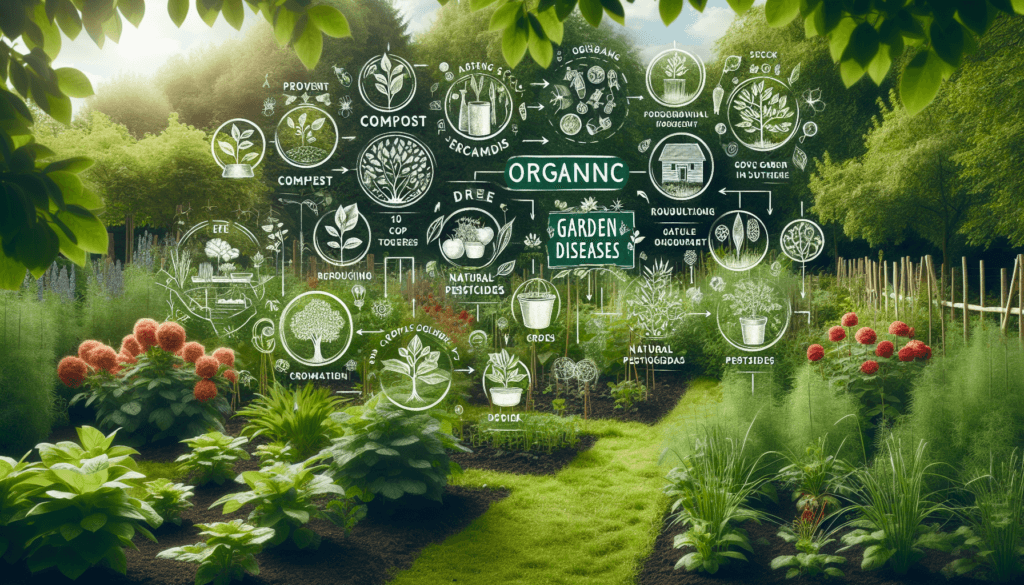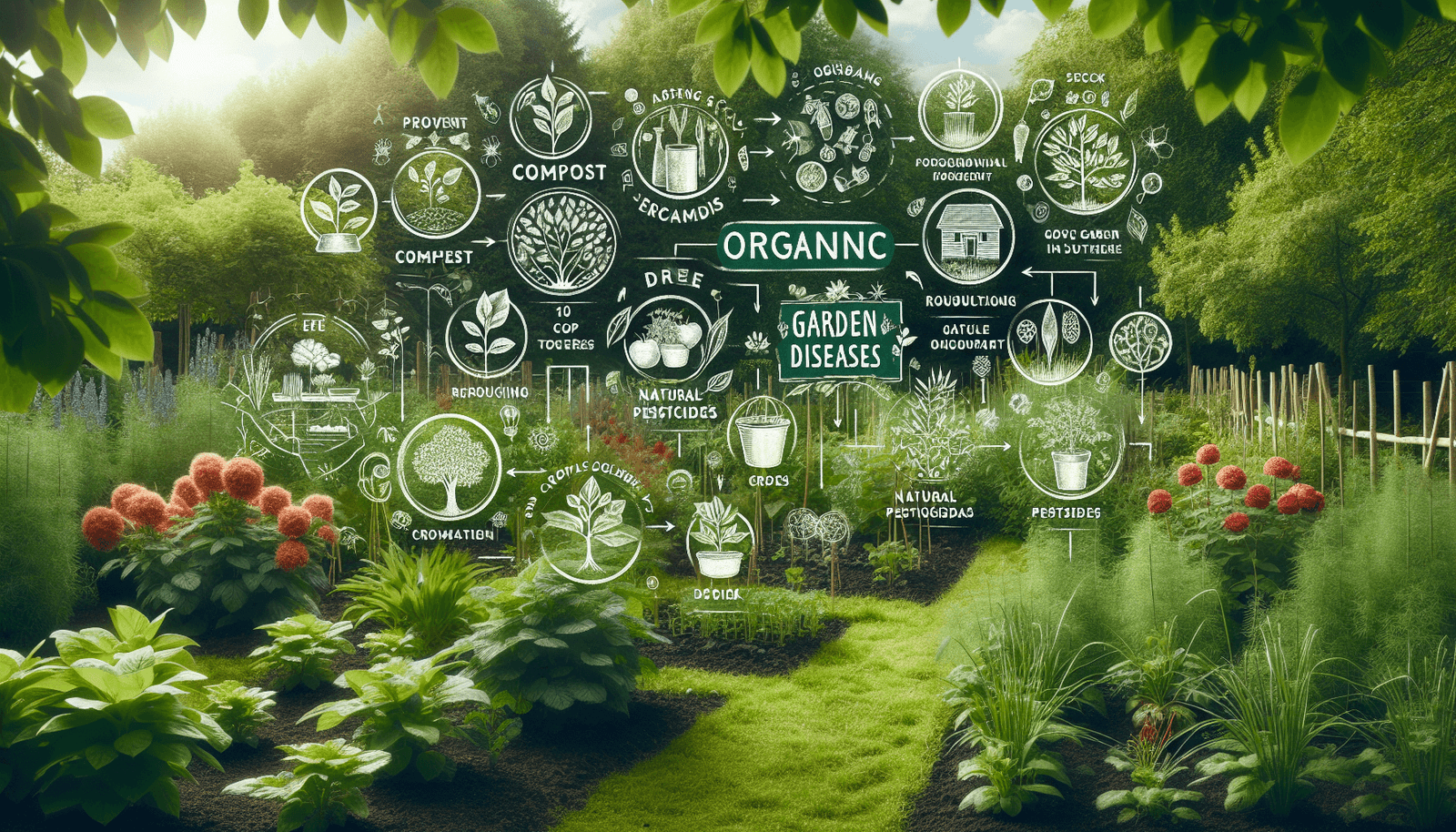Maintaining a healthy and vibrant garden can feel like a never-ending battle, but fret not! In this article, we will explore the top 10 eco-friendly methods to control garden diseases. With these practical and sustainable solutions at your disposal, you can protect your plants and ensure a flourishing garden without harming the environment. So, roll up your sleeves and get ready to discover effective techniques that will keep your garden thriving!

Crop Rotation
Benefits of crop rotation
Crop rotation is a simple and effective technique that you can use to keep your garden healthy and disease-free. By rotating the types of crops you plant in each bed or area of your garden, you can help prevent the buildup of disease-causing organisms in the soil.
One of the main benefits of crop rotation is that it helps break the lifecycle of pests and pathogens. Different plants have different nutritional needs, and by rotating crops, you can interrupt the reproduction cycle of pests and diseases that only target specific plants. This reduces the risk of outbreaks and helps to maintain the health of your garden.
Another advantage of crop rotation is its ability to improve soil health. Some crops, like legumes, have the ability to fix nitrogen in the soil, which is beneficial for other plants. By rotating legume crops with other vegetables, you can increase soil fertility and reduce the need for synthetic fertilizers.
Effective rotation strategies
To effectively implement crop rotation in your garden, there are a few key strategies to keep in mind. First, divide your garden into distinct sections or beds. Aim to rotate crops on a three to four-year cycle, as this is generally sufficient to disrupt the life cycles of most pests and diseases.
It is best to group plants with similar nutrient requirements together in each bed. For example, you could plant heavy feeders, such as tomatoes and peppers, in one bed, and follow them with light feeders like leafy greens or herbs. This way, you can limit the depletion of specific nutrients and promote overall soil health.
It’s also important to avoid planting crops from the same family in consecutive years. Some diseases and pests have a preference for certain plant families, so rotating crops within families can help reduce the risk of infection.
Keep in mind that crop rotation is not a foolproof method, but it is an excellent way to complement other disease control techniques and maintain a healthy garden.
Companion Planting
Complementary plant combinations
Companion planting is a centuries-old technique that involves planting different species of plants together to benefit one another. By strategically placing plants with complementary characteristics in close proximity, you can enhance the growth and health of your garden.
Companion planting offers several advantages in disease control. Some plants release certain chemicals or compounds that repel pests or inhibit the growth of harmful pathogens. For instance, marigolds are known to deter nematodes, a type of microscopic worm that can cause damage to plant roots.
Additionally, companion plants can attract beneficial insects that feed on pests. For example, planting flowers like lavender or dill can attract pollinators, such as bees and butterflies, which not only aid in plant reproduction but also help control pest populations.
Disease prevention through companion planting
Companion planting can also help prevent the spread of diseases in your garden. Some plants have natural resistance to specific diseases, and by growing them alongside susceptible plants, you can create a barrier or buffer zone that limits the spread of pathogens.
For example, planting onions alongside carrots has been found to reduce carrot fly infestations. Onions emit a strong odor that repels the carrot flies, reducing the likelihood of damage to the carrot plants.
It’s important to research compatible companion plants and their benefits before planning your garden layout. By carefully selecting and arranging your plants, you can create a harmonious and disease-resistant garden ecosystem.
Natural Predators
Introduction of beneficial insects
When it comes to battling pests and diseases in your garden, harnessing the power of nature’s defenders can be incredibly effective and eco-friendly. Beneficial insects and other natural predators can help control pest populations by feeding on pests or parasitizing them.
Introducing beneficial insects to your garden is a proactive and sustainable approach to pest and disease management. Ladybugs, lacewings, and parasitic wasps are examples of beneficial insects that feed on common garden pests like aphids and caterpillars.
To attract these helpful critters, you can plant flowers and herbs that provide them with food and shelter. Nectar-producing flowers such as cosmos, daisies, and sunflowers are popular choices. Having a diverse range of plants and habitats in your garden will encourage the presence of these beneficial insects.
Attracting birds and bats
Birds and bats are natural predators that feed on a wide range of insects, including those that can cause disease in your garden. Encouraging these flying friends to visit your garden can help keep pests in check.
Providing bird feeders and water baths can attract birds to your garden. Additionally, planting trees and shrubs that provide berries, seeds, or nesting sites will create an inviting environment for feathered visitors.
If you have a suitable location, you can also install a bat house to attract bats. Bats are voracious eaters of insects and can consume large numbers of pests in a single night. Providing a safe and cozy home for bats can be a game-changer in your fight against garden diseases.
Proper Sanitation
Cleaning garden tools and equipment
Maintaining proper sanitation practices in your garden is crucial for disease prevention. Dirty tools and equipment can harbor pathogens and spread diseases from one plant to another. Regularly cleaning and disinfecting your gardening tools can help keep your garden healthy.
After each use, make it a habit to wipe down your tools with a clean cloth and sanitize them using a bleach solution or a commercial disinfectant. Be sure to clean both metal and wooden handles, as well as the blades or prongs of the tools. Rinse them with water and allow them to air dry before storing them.
Removing infected plants and debris
The presence of diseased plants and debris in your garden can act as a reservoir for pathogens, allowing them to persist and infect healthy plants. It is essential to promptly remove any infected plants, leaves, or fruits and dispose of them properly.
When removing diseased plants, be careful not to spread the disease further. Use clean tools to cut off the infected portions of the plant, ensuring you make clean cuts. Place the infected material in a sealed bag and dispose of it in the trash. Do not compost diseased plant materials, as this can potentially reintroduce the pathogens into your garden.
In addition to removing infected plants, it’s also important to regularly clean up fallen leaves, plant debris, and weeds. These can provide hiding places and breeding grounds for pests and diseases. Maintaining a clean and tidy garden environment reduces the risk of disease outbreaks and promotes overall plant health.

Organic Fertilizers
Benefits of organic fertilizers
Proper nutrition is essential for plant health and disease resistance. Organic fertilizers offer a natural and eco-friendly way to provide essential nutrients to your plants, promoting their overall vigor and immune system.
One of the significant benefits of organic fertilizers is that they slowly release nutrients into the soil, providing a steady and balanced supply to your plants. This gradual release minimizes the risk of nutrient imbalances and excessive fertilization, which can weaken plants and make them more susceptible to diseases.
Organic fertilizers also help improve soil structure and increase its water-holding capacity. This contributes to a healthier root system and better nutrient uptake, enhancing plant resilience against diseases.
Types of organic fertilizers
There are various types of organic fertilizers that you can use in your garden. Compost is a popular choice and can be made from a combination of kitchen scraps, yard waste, and other organic materials. It enriches the soil with a wide range of nutrients and provides beneficial microorganisms that promote soil health.
Another option is manure, which is rich in essential nutrients. Make sure to use properly composted manure, as fresh manure can contain harmful bacteria that can contaminate the soil and plants.
Other organic fertilizers include bone meal, blood meal, fish emulsion, and seaweed extract. Each has its specific nutrient composition and can be used to address specific deficiencies or add general nutrition to your plants.
When using organic fertilizers, it’s important to follow package instructions and avoid over-application, as excessive amounts can lead to nutrient imbalances and environmental pollution. Organic fertilizers work best when used as part of a holistic approach to soil health and disease prevention.
Mulching
Types of mulches for disease control
Mulching is an effective technique for maintaining soil moisture, suppressing weeds, and preventing the spread of diseases. Mulch acts as a protective layer over the soil, reducing the likelihood of soil-borne diseases reaching your plants.
Choosing the right mulch can play a significant role in disease control. Organic mulches, such as straw, wood chips, or shredded leaves, can help create a favorable environment for beneficial soil organisms, which can suppress the growth of pathogens.
Certain organic mulches also release compounds that have antimicrobial properties, reducing the risk of soil-borne diseases. For example, using straw mulch can inhibit the growth of fungal pathogens that cause diseases like damping-off or root rot.
Proper mulching techniques
To effectively use mulch for disease control, apply a layer of mulch around your plants, ensuring that it covers the soil surface but does not make direct contact with the plant stems. Direct contact can trap moisture against the stems, promoting the growth of disease-causing pathogens.
Maintain a mulch layer of around 2 to 4 inches thick, being careful not to pile the mulch up against the plant’s base. Leave a small gap to allow for airflow and to prevent excess moisture from accumulating.
Regularly monitor your mulch layer and replenish it as needed. Mulch decomposes over time, so it’s important to add fresh mulch annually or as it breaks down. By properly mulching your garden, you can create a healthy and disease-resistant environment for your plants.

Proper Watering
Watering techniques to prevent diseases
Proper watering practices are essential for maintaining the health of your plants and preventing the development of diseases. Overwatering or improper watering can create a favorable environment for the growth of pathogens and weaken plants, making them more susceptible to diseases.
To prevent disease, it’s important to water your plants at the right time and in the right way. One of the best practices is to water in the early morning or late afternoon when the temperature is cooler and the sun is less intense. This allows the plants to absorb the moisture without the risk of excess evaporation or prolonged leaf wetness.
Additionally, it’s best to water at the base of the plants, directly onto the soil, rather than overhead watering. Overhead watering can lead to prolonged leaf wetness, which can contribute to the development of fungal diseases. Drip irrigation or soaker hoses are ideal for precise watering and reducing the risk of foliar diseases.
Monitor the moisture levels of your soil regularly to avoid under or overwatering. Different plant species have different water requirements, so it’s essential to understand the specific needs of your plants and adjust your watering accordingly. Providing the right amount of water will promote healthy plant growth and minimize the risk of diseases.
Drip irrigation systems
Drip irrigation systems are an excellent tool for disease prevention in your garden. These systems deliver water directly to the root zone of the plants, minimizing water waste and reducing the risk of foliar diseases.
Drip irrigation systems consist of tubes or hoses with emitters that evenly distribute water along the planting beds. They allow for precise watering, delivering water slowly and directly to the plants’ roots. This promotes deep root growth, making plants more resilient to drought and less susceptible to diseases.
By providing a consistent and controlled water supply, drip irrigation minimizes moisture fluctuations in the soil, reducing the likelihood of fungal diseases caused by excess moisture. The targeted application of water also helps to conserve water by minimizing evaporation and runoff.
Drip irrigation systems can be customized to fit the specific layout and needs of your garden. Whether you have a small vegetable patch or a larger garden, installing a drip irrigation system can be an eco-friendly and efficient way to water your plants while preventing diseases.
Compost Tea
Benefits of compost tea
Compost tea is a nutrient-rich liquid fertilizer that is made by steeping compost in water. It is a powerful tool for promoting soil and plant health, as well as improving disease resistance.
One of the main benefits of compost tea is its ability to add beneficial microorganisms to the soil. These microorganisms help break down organic matter, improve soil structure, and suppress the growth of disease-causing pathogens. They can also enhance nutrient availability to plants, promoting their overall health.
Compost tea also contains a range of nutrients that are essential for plant growth. These nutrients are present in a soluble form, making them easily accessible to plants. Regular application of compost tea can provide a steady supply of nutrients, reducing the risk of nutrient deficiencies and enhancing disease resistance.
Preparing and applying compost tea
To prepare compost tea, fill a container with water and add a generous amount of compost. Let the compost steep in the water for about 24 to 48 hours, stirring occasionally. Afterward, strain the liquid to remove any remaining solid particles.
To apply the compost tea, it’s best to use a sprayer or watering can with a fine nozzle. Apply the tea directly to the soil around the base of the plants, ensuring good coverage. Avoid spraying the tea onto the leaves, as this can promote the growth of fungal diseases.
Apply compost tea regularly throughout the growing season, every two to three weeks, to provide a consistent supply of nutrients and beneficial microorganisms to your plants. It’s important to note that compost tea is a supplemental fertilizer and should be used in conjunction with other organic fertilizers and good cultural practices.
Compost tea can be a valuable addition to your disease control arsenal, nourishing your plants and creating a vibrant and resilient garden ecosystem.

Biocontrol Agents
Introduction to biocontrol agents
Biocontrol agents are living organisms that are used to control pests and diseases naturally. They can be insects, nematodes, fungi, or bacteria that prey on or parasitize specific pests, helping to maintain a balance in the garden ecosystem.
Using biocontrol agents is an eco-friendly alternative to chemical pesticides, as they target specific pests, leaving beneficial insects unharmed. They can be effective in reducing pest populations and preventing damage caused by pests and diseases.
Examples of biocontrol agents include ladybugs, which feed on aphids, and nematodes that parasitize insect larvae. These organisms can be purchased commercially and released in your garden as part of an integrated pest management approach.
Effective use of biocontrol agents
To effectively use biocontrol agents, it’s important to understand their life cycle and optimal conditions for release. Many biocontrol agents have specific environmental requirements and may need to be released at certain times or in specific areas of your garden.
Carefully read the instructions provided with the biocontrol agents and follow them accordingly. Some agents may need to be stored or refrigerated before release, while others require certain weather conditions or specific host plants.
It’s also important to monitor the effectiveness of biocontrol agents and adjust your management strategies as needed. Regular observation of pest populations and damage levels will help you determine whether additional releases or alternative control methods are necessary.
By utilizing biocontrol agents, you can harness the power of natural predators and create a more sustainable and balanced garden ecosystem.
Disease-Resistant Varieties
Benefits of using disease-resistant varieties
Using disease-resistant varieties of plants is a proactive and effective way to combat garden diseases. Disease-resistant plants have genetic traits that enable them to withstand or fend off specific diseases, reducing the need for chemical interventions.
One of the main benefits of disease-resistant varieties is their ability to save time, effort, and money. By planting resistant plants, you can minimize the risk of disease outbreaks and the subsequent need for intensive disease management. This means less time spent spraying pesticides or applying other disease control measures.
Disease-resistant plants also offer increased flexibility and choice in your garden. With advancements in plant breeding, there is now a wide variety of disease-resistant options available for many popular garden plants. This allows you to select and grow the plants you desire without the fear of diseases ravaging your garden.
Choosing and planting resistant plants
When selecting disease-resistant varieties, it’s important to consider the specific diseases that commonly affect your region or plants of interest. Different plants have different susceptibilities, so it’s essential to choose varieties that are known to have resistance to the diseases that you are likely to encounter.
Consult gardening references, catalogs, or local plant nurseries to find information on disease-resistant varieties. These resources often provide valuable insight into the specific diseases that a plant is resistant to, helping you make informed decisions.
Once you have chosen disease-resistant plants, follow proper planting and care practices to maximize their resilience. Plant them in well-drained soil, provide appropriate nutrition, and maintain good cultural practices. Remember that disease resistance does not make a plant invincible, but it significantly reduces the risk of disease and promotes overall garden health.
By embracing disease-resistant varieties, you can enjoy a beautiful and bountiful garden while reducing the reliance on chemical interventions and fostering a more sustainable environment.
In conclusion, there are numerous eco-friendly ways to control garden diseases while maintaining a healthy and productive garden. From implementing crop rotation and companion planting to utilizing natural predators and proper sanitation techniques, there are various strategies that can be employed to prevent and manage diseases. Additionally, organic fertilizers, mulching, proper watering, and the use of compost tea can improve soil health and bolster plant immunity. Finally, incorporating biocontrol agents and selecting disease-resistant plant varieties offer effective long-term solutions to mitigate garden diseases. By adopting these practices, you can create a thriving garden ecosystem that is resilient to diseases and supports a sustainable environment.



